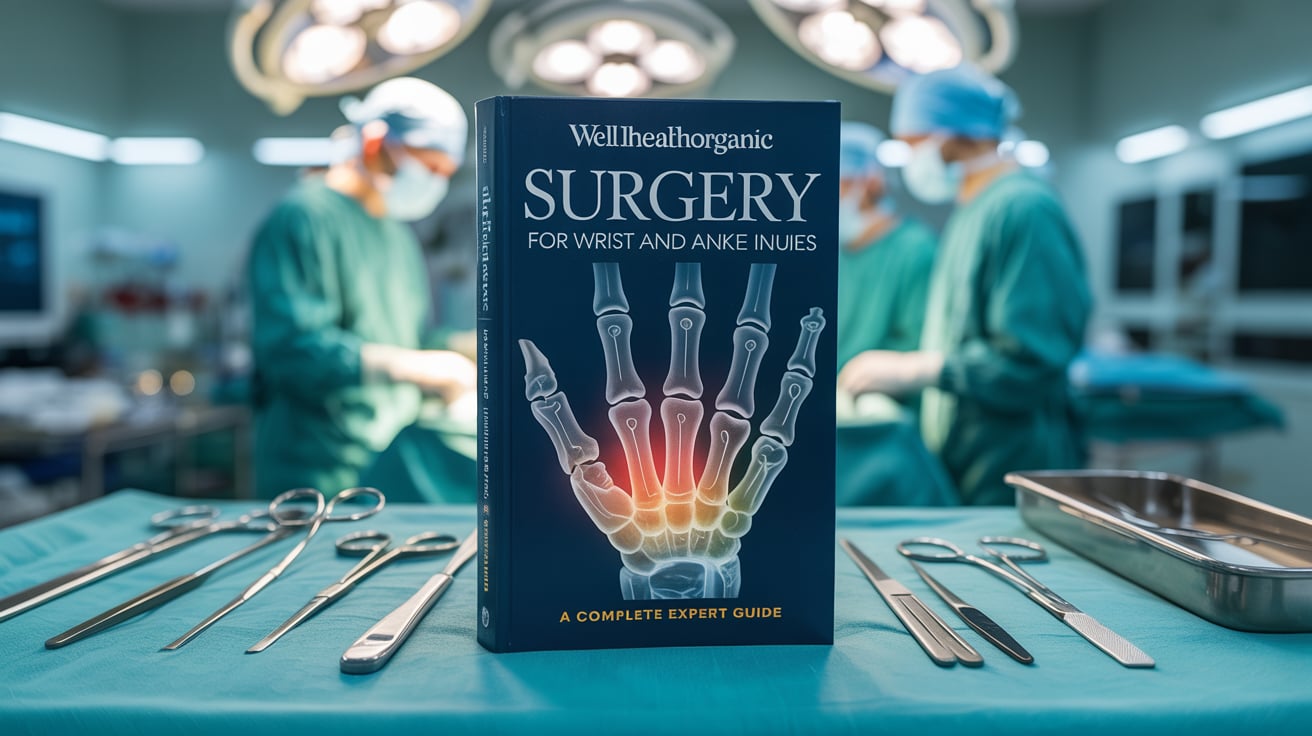When daily life or athletic performance is interrupted by joint injuries, recovery becomes a top priority. Among the most common musculoskeletal problems are wrist and ankle injuries, which affect balance, grip, and overall mobility. In recent years, wellhealthorganic surgery for wrist and ankle injuries has gained attention for combining advanced orthopedic techniques with a patient-centered, minimally invasive approach.
This method not only repairs damage but also helps patients regain natural movement, reduce long-term pain, and prevent future complications. Let’s take a closer look at why this modern surgical technique is becoming a trusted solution for joint health.
Why Wrist and Ankle Injuries Need Special Care
Unlike many other joints, the wrist and ankle are highly complex. Both contain multiple bones, ligaments, and tendons working together for precise motion and weight-bearing. Because of this complexity:
- Even small injuries can disrupt daily life.
- Repeated stress can lead to chronic instability.
- Untreated injuries may progress to arthritis.
This is where wellhealthorganic surgery for wrist and ankle injuries plays an essential role—it goes beyond fixing the injury and emphasizes long-term joint preservation.
What Are the Most Common Wrist and Ankle Injuries?
Before diving into surgical options, it’s important to understand the typical conditions that lead to treatment:
- Sprains – Overstretched or torn ligaments causing instability and swelling.
- Fractures – Bone breaks that may require surgical alignment.
- Tendon Injuries – Tears or inflammation from repetitive use or sudden trauma.
- Ligament Tears – Especially common in the ankle after repeated sprains.
- Cartilage Damage – Often resulting in stiffness, pain, or early arthritis.
Not all of these require surgery, but when conservative care fails, wellhealthorganic surgery for wrist and ankle injuries can provide effective, lasting relief.
When Is Surgery Recommended?
Doctors usually begin with non-surgical methods such as rest, ice, bracing, or physical therapy. Surgery becomes necessary if:
- A fracture is displaced or complex.
- Ligaments are torn, leading to persistent instability.
- A tendon rupture prevents normal movement.
- Chronic arthritis causes daily pain.
- Conservative treatments fail after weeks or months.
In these cases, wellhealthorganic surgery for wrist and ankle injuries becomes the next step for restoring function.
Surgical Techniques Used in Wellhealthorganic Surgery
Modern surgical advancements have made procedures safer and more effective. Common techniques include:
1. Minimally Invasive Arthroscopy
- Surgeons insert a tiny camera and tools through small incisions.
- This allows them to repair damage with minimal trauma.
- Benefits include faster recovery, less pain, and smaller scars.
2. Internal Bracing and Ligament Repair
- High-strength materials support weakened ligaments.
- Techniques like the Broström procedure provide long-term joint stability.
3. Fracture Fixation
- Plates, pins, or screws realign broken bones.
- Ensures proper healing and prevents deformity.
4. Tendon Repair or Transfer
- Torn tendons are stitched together.
- In severe cases, a healthy tendon may be transferred to restore function.
5. Joint Fusion or Replacement
- Fusion reduces pain by stabilizing bones but limits flexibility.
- Replacement restores motion with artificial joints, especially in arthritis.
These options make wellhealthorganic surgery for wrist and ankle injuries adaptable to a wide range of conditions.
Advantages of Wellhealthorganic Surgery
Compared to traditional open surgeries, this modern approach offers:
- Reduced Pain & Scarring – Thanks to minimally invasive incisions.
- Faster Healing – Patients return to daily activities quicker.
- Better Joint Function – Structural repair improves stability and mobility.
- Customized Care – Treatment plans are designed around individual needs.
- Long-Term Results – Decreased risk of chronic pain and recurring injuries.
This blend of technology and personalization sets wellhealthorganic surgery for wrist and ankle injuries apart from standard procedures.
Preparing for Surgery
Preparation directly impacts recovery outcomes. The process generally involves:
- Diagnosis & Consultation – Imaging tests like X-rays or MRIs confirm the injury.
- Surgical Plan – The surgeon decides the most effective procedure.
- Day of Surgery – Local or general anesthesia is administered, and the operation is performed.
- Immediate Care – Post-surgery pain and swelling are managed with medication and support devices.
- Rehabilitation Program – Tailored physical therapy begins soon after to restore mobility.
Rehabilitation & Recovery Tips
Recovery time varies, but success largely depends on proper rehabilitation:
- Early Immobilization – A cast, brace, or boot supports healing for 2–6 weeks.
- Gradual Weight Bearing – Walking aids like crutches may be required at first.
- Physical Therapy – Exercises rebuild strength, range of motion, and stability.
- Healthy Nutrition – A protein-rich, calcium-balanced diet supports tissue repair.
- Regular Check-ups – Monitoring ensures bones and soft tissues heal properly.
Most patients regain normal activity within 8–12 weeks, though major surgeries may take 6–12 months for full recovery.
Choosing the Right Clinic and Surgeon
Selecting the right specialist is crucial for the best outcome. Look for:
- Orthopedic surgeons with wrist and ankle expertise.
- Clinics using arthroscopy and internal bracing.
- Strong rehabilitation programs for post-surgery recovery.
- A proven track record of successful outcomes.
The success of wellhealthorganic surgery for wrist and ankle injuries often depends as much on the surgeon’s experience as on the procedure itself.
Real-Life Success Stories
Patients who undergo these surgeries frequently report life-changing improvements:
- Athletes with unstable ankles return to sports with greater stability.
- Workers recover hand strength to perform daily tasks without discomfort.
- Elderly patients with arthritis experience reduced pain and improved independence.
These outcomes highlight how wellhealthorganic surgery for wrist and ankle injuries restores not just physical function, but confidence and quality of life.
The Future of Wrist and Ankle Surgery
Innovations continue to refine orthopedic care:
- Robotic-Assisted Surgery for unmatched precision.
- Bioprinting for patient-specific implants.
- Stem Cell Integration for enhanced tissue regeneration.
- AI-Assisted Rehabilitation to track and optimize recovery.
As these technologies evolve, the effectiveness of wellhealthorganic surgery for wrist and ankle injuries will only grow stronger.
Conclusion
Wrist and ankle injuries can drastically reduce quality of life, but modern surgical solutions offer hope. With techniques like minimally invasive arthroscopy, internal bracing, and customized rehabilitation programs, wellhealthorganic surgery for wrist and ankle injuries provides a safe, effective, and lasting solution.
By choosing the right clinic, preparing properly, and committing to recovery, patients can look forward to restored mobility, reduced pain, and a healthier, more active lifestyle.




